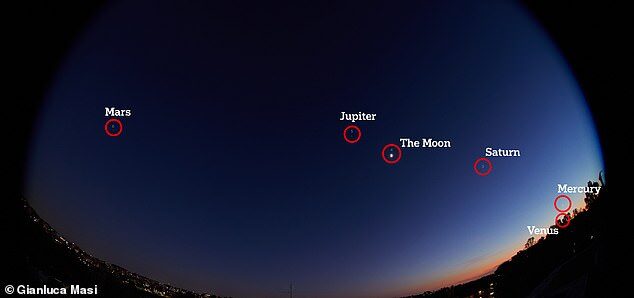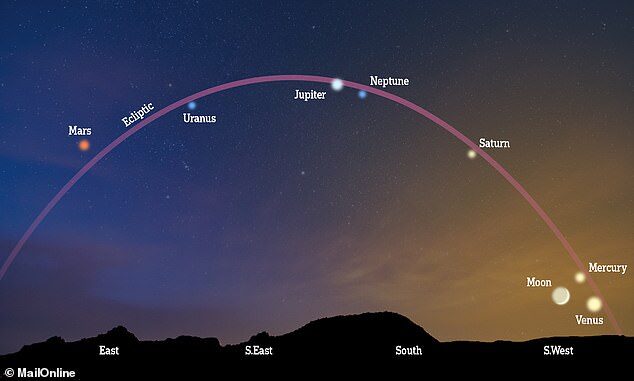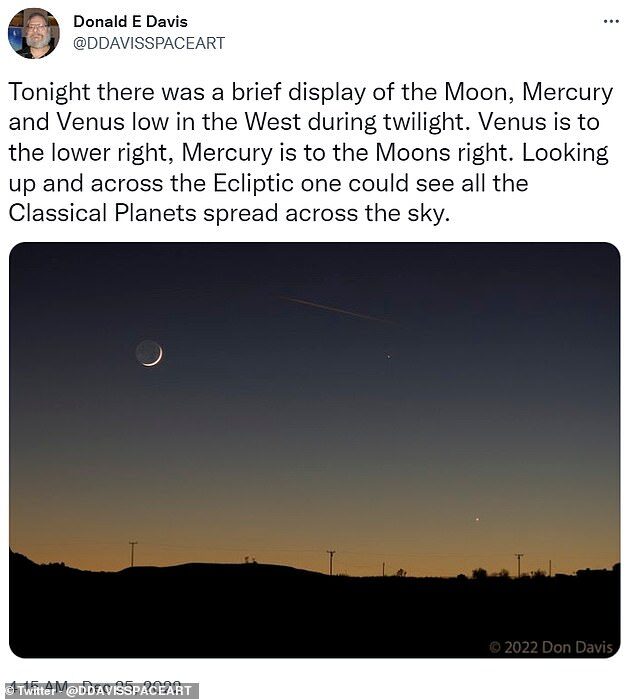
Mercury, Venus, Mars, Jupiter and Saturn can all be seen with the naked eye, while Uranus and Neptune are possible to spot with binoculars or a telescope.
Astronomer Dr Gianluca Masi shared a picture he took of the five planets that could be seen with the naked eye, while other skywatchers across the world also captured images of the 'planet parade'. He took it from the roof of a building in Rome, Italy last night, using a camera with special lenses.

The solar system will put on a show for space fans for the next two evenings, with all seven planets other than Earth visible in the night sky
Dr Masi, who works with the Virtual Telescope Project, told MailOnline: 'The opportunity to see all the planetary family at a glance does not happen often.
'We can get a better idea of the cosmic place where we live by looking at the other planets.
'We have just a couple of days to look at this parade, before Mercury will disappear into the solar glare.'
This week, Twitter users from across the globe, including Japan and the US, have been sharing photos of the spectacle online.
The phenomenon is known to occur about once every two years.
All planets appeared in the night sky as small points of light to stargazers in the northern hemisphere. Mercury is the hardest planet to see without magnification, as it is sitting in a bright part of the sky, however it can be spotted close to the much brighter Venus which outshines it by 70 times.
Tonight, the two reach conjunction - their closest point - at 21:00 GMT (16:00 ET), and they won't appear this close again until 2024.
They can be spotted low in the west, and will get the best view about half an hour after sunset, with Venus disappearing about 40 minutes later.
The rest of the planets line up eastwards, with Jupiter appearing brighter than all the stars and high in the southern sky.
While the largest planet in our solar system disappears just before midnight, Mars is visible all night after it rises in the east just before sunset.
It will appear red and brighter than most stars, while its neighbour Saturn will be a golden colour when it appear in the south west after darkness falls.
The ringed planet will set at about 20:00 GMT (15:00 ET), but drawing earlier and earlier as the month goes on.

My shot from last evening in Charlottesville - I labeled all the naked-eye visible planets, and marked where the other are located (visible with telescopes).
Dr Masi told MailOnline:
'We still have a couple of days to try to see this planetary alignment.The five worlds shine in a row because they all travel on the plane of the solar system, known as the ecliptic.
'What is important is to choose an observing site offering an unobstructed view on the western horizon, where Venus and Mercury will be very low.
'To see this planetary parade, you just need to look up soon after sunset; as soon as the sky is dark enough to spot, on the southwestern horizon, planet Venus, which is easy to find, being very bright.
'Then, Mercury is within a couple of degrees from it, these next couple of days, but much fainter. 'It should be visible by naked eye before it sets, but binoculars will make it easy to see the innermost planet.
'Then, we have Saturn, Jupiter and Mars, plus the moon not far from Jupiter.
'Binoculars will also show Uranus and Neptune, so that the entire planetary system can be explored in a few minutes.'
A 'planet parade' was last visible from the UK in June, when it was also joined by a crescent moon.
The five planets visible to the naked eye all appeared in the order of their distance from the sun - a line-up that had not been seen for 18 years.
How to watch:
At about half an hour after sunset, look for Venus in the southwestern sky, close to the horizon. Mercury will appear very close by.
The rest of the planets - Saturn, Jupiter and Mars - will line up eastwards and sequentially higher in the sky.
They will all be visible to the naked eye until about 20:00 GMT (15:00 ET).
Uranus, located between Mars and Jupiter, and Neptune, which is between Saturn and Jupiter, will also be visible with binoculars or telescope.




Jason from Archaix.com says 2040 as well.